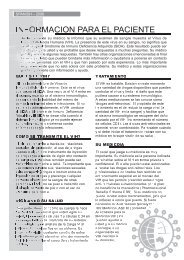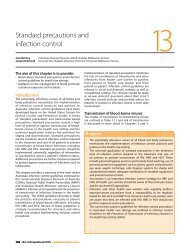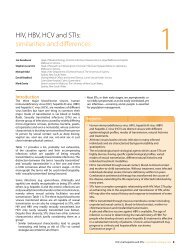B Positive – all you wanted to know about - ASHM
B Positive – all you wanted to know about - ASHM
B Positive – all you wanted to know about - ASHM
Create successful ePaper yourself
Turn your PDF publications into a flip-book with our unique Google optimized e-Paper software.
NATURAL HISTORY OF CHRONIC<br />
HEPATITIS B VIRUS INFECTION<br />
Marianne Guirgis Gastroenterology and Hepa<strong>to</strong>logy Department, St George Hospital, Kogarah, NSW.<br />
Amany Zekry Hepa<strong>to</strong>logy Unit, St George Hospital, Kogarah, NSW.<br />
Links <strong>to</strong>: Chapter : Virology: viral replication and drug resistance<br />
Chapter 3: Hepatitis B virus testing and interpreting test results<br />
Chapter 6: Clinical assessment of patients with HBV infection<br />
Chapter 9: Hepatitis B virus-related hepa<strong>to</strong>cellular carcinoma<br />
Chapter 10: Managing hepatitis B virus infection in complex situations<br />
KEY POINTS<br />
Transmission routes and risks<br />
Hepatitis b virus (HbV) infection is a viral<br />
infection spread by contact with infected blood<br />
or bodily fluids, including semen and saliva. the<br />
virus may be transmitted:<br />
� Vertic<strong>all</strong>y, between a mother with chronic<br />
infection and her baby<br />
� Horizont<strong>all</strong>y, through close person-<strong>to</strong>-person<br />
contact, usu<strong>all</strong>y in childhood (e.g. through<br />
open cuts or sores)<br />
� Parenter<strong>all</strong>y, via injecting drug use (idu)<br />
� sexu<strong>all</strong>y.<br />
40 b <strong>Positive</strong> <strong>–</strong> <strong>all</strong> <strong>you</strong> <strong>wanted</strong> <strong>to</strong> <strong>know</strong> <strong>about</strong> hepatitis b: a guide for primary care providers<br />
4<br />
� birth in a highly endemic country is a risk fac<strong>to</strong>r for developing chronic hepatitis b infection (cHb).<br />
the primary mode of transmission in such cases is vertical (mother-<strong>to</strong>-child).<br />
� the risk of developing chronic hepatitis b infection is highest in those who acquire hepatitis b virus<br />
(HbV) perinat<strong>all</strong>y and lowest in those who acquire the infection in adulthood.<br />
� the natural his<strong>to</strong>ry of HbV infection depends on complex host, viral, and environmental<br />
interactions.<br />
� there are four phases of chronic HbV infection and the host immune response in each phase<br />
determines the outcome of infection and the severity of liver injury.<br />
� complications of chronic HbV infection include cirrhosis with hepa<strong>to</strong>cellular failure and<br />
hepa<strong>to</strong>cellular carcinoma (Hcc).<br />
Risk fac<strong>to</strong>rs<br />
� birth in a highly endemic country, e.g. east<br />
or south asia, european Mediterranean<br />
countries, the Middle east, eastern europe,<br />
south america, the caribbean and south<br />
Pacific islands<br />
� High-risk sexual behaviour, including men<br />
who have sex with men (MsM) and sex<br />
workers<br />
� indigenous australians<br />
� Household contacts of people who are<br />
Hbsag positive<br />
� injecting drug use (idu)<br />
� contaminated blood products<br />
� contaminated surgical equipment<br />
� tat<strong>to</strong>os<br />
� Previous imprisonment<br />
� Haemodialysis.






